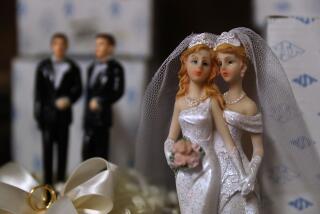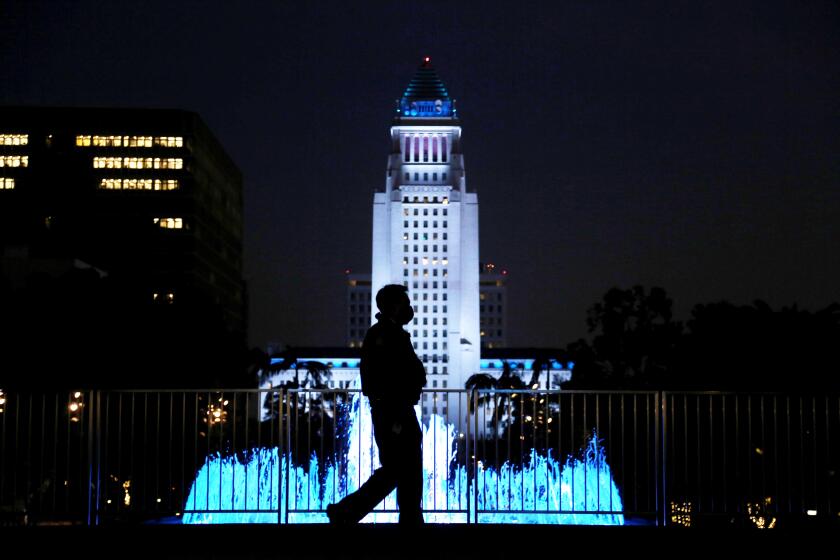<b>Timeline:</b> Proposition 8The battle over gay marriage in California
- Share via
Jan. 3, 2000:
California starts registering domestic partners. While groundbreaking, the law affords same-sex couples only two benefits: hospital visitation rights and health insurance coverage for the dependents of government employees covered by CalPERS, the state retirement system.
Mar. 7, 2000:
More than 61% of Californians approve a ballot measure declaring that marriage should remain reserved for couples of the opposite sex. Just 14 words long, Proposition 22 was one of the shortest initiatives ever placed on a California ballot. Yet it ignited an emotional $16-million campaign that set church against church, neighbor against neighbor and relative against relative.
Oct. 14, 2001:
Gov. Gray Davis signs a bill that substantially expands the rights granted domestic partners. The bill adds about a dozen legal benefits, including the right to make medical decisions for a partner in the hospital, use sick leave to care for an ill or incapacitated partner and relocate with a partner without losing unemployment benefits.
Sept. 19, 2003:
Gov. Gray Davis signs a bill that gives state-registered domestic partners many of the legal rights and obligations of married couples in matters involving children, money and property. While stopping short of recognizing gay marriage, the law gives a partner the right to financial support and child custody after a partnership is dissolved and gives a survivor the right to collect his or her partner’s government benefits.
Feb. 12, 2004:
Mayor Gavin Newsom instructs city officials to issue marriage licenses to same-sex couples, the first action of its kind in the nation. Dozens of couples are married as city offices stay open late to accommodate long lines.
Mar. 3, 2004:
The Los Angeles County Board of Supervisors and the Los Angeles City Council pass resolutions opposing a constitutional amendment to ban same-sex marriages.
Mar. 11, 2004:
The California Supreme Court unanimously orders San Francisco to stop marrying gay couples and announces that it will rule on the legality of the city’s actions within the next few months. In four weeks, nearly 4,000 gay couples received licenses.
Aug. 12, 2004:
The California Supreme Court rules unanimously that San Francisco’s mayor overstepped his authority by issuing same-sex marriage licenses this spring. By a 5-2 vote, the court also declares the roughly 4,000 marriages of gay and lesbian couples that had been sanctioned by the city “void from their inception and a legal nullity.”
Dec. 21, 2004:
San Francisco judge hears arguments on same-sex marriages. At the heart of the consolidated lawsuits -- brought by the city of San Francisco and a dozen gay and lesbian couples -- is the contention that current law defining marriage as “between a man and a woman” violates the state Constitution by denying homosexuals the “fundamental right” to marry the person of their choosing.
June 29, 2005:
The California Supreme Court declines to hear a challenge to the state’s sweeping domestic partners benefits law. Critics of the law thought such benefits would be prohibited by Proposition 22.
Aug. 22, 2005:
The California Supreme Court rules that children born to gay couples have two legally recognized parents -- the first such ruling in the nation.
Sept. 29, 2005
Gov. Arnold Schwarzenegger vetoes a same-sex marriage bill after it passed the Senate and Assembly. Schwarzenegger says the bill would wrongly reverse Proposition 22, which declares that marriage is only between a man and a woman.
June 5, 2007:
A measure to legalize marriage for gay couples easily passes the California Assembly after a respectful debate. As he did in 2005, Gov. Arnold Schwarzenegger is expected to veto the measure.
Sept. 19, 2007:
An emotional Mayor Jerry Sanders abruptly reverses his public opposition to same-sex marriage. Sanders, tears welling and voice breaking, says he realizes that he can not tell his daughter Lisa, who is gay, that her relationship with a partner is not as important as that of a straight couple.
Oct. 12, 2007
California Gov. Arnold Schwarzenegger vetoes a bill approved by state lawmakers that would legalize gay marriage. He says the courts need to rule on the legality of Proposition 22, the gay marriage ban passed by voters.
Mar. 4, 2008:
The California Supreme Court considers four lawsuits brought by same-sex couples after San Francisco issued marriage licenses in 2004. Three of the court’s seven justices indicate they will uphold state law defining marriage as between a man and a woman. Ruling expected within 90 days.
May 15, 2008:
The California Supreme Court rules that the state Constitution protects a fundamental “right to marry” that extends equally to same-sex couples. The three dissenting justices argue that it is up to the electorate or the Legislature to decide whether gays should marry.
June 2, 2008:
More than one million signatures are submitted for a ballot measure that would amend the state Constitution to define marriage as a union “between a man and a woman” and undo the California Supreme Court ruling allowing gay marriages.
June 16, 2008:
County registrars and clerks in Los Angeles, San Francisco, Alameda, Sonoma and Yolo counties keep offices open to allow at least two dozen same-sex couples the distinction of being among the first to wed. Seven Southern California Roman Catholic bishops, including L.A. Cardinal Roger Mahony, reaffirm their opposition to same-sex marriage.
July 16, 2008:
The California Supreme Court rejects arguments that Proposition 8 -- which if passed by voters would amend the state Constitution to ban gay marriage -- is an illegal constitutional revision. Justices also reject the argument that voters had been misled when they signed petitions to put it on the ballot.
Nov. 4, 2008:
California voters pass Proposition 8 -- which amends the state Constitution to ban gay marriage -- with about 52% of the vote. A 2000 ballot initiative banning gay marriage, Proposition 22, had passed with 61% of the vote but was later struck down by the state’s high court.
Nov. 19, 2008:
The California Supreme Court votes 6 to 1 to review legal challenges to Proposition 8, but refuses to permit gay weddings to resume pending a final decision.
Mar. 2, 2009:
The California state Senate approves a resolution calling Proposition 8, the voter-approved ban on gay marriage, an improper revision of the California Constitution because it was not approved by the Legislature.
Mar. 5, 2009:
The California Supreme Court strongly indicates it will rule that Proposition 8 validly abolished the right for gays to marry but will allow same-sex couples who wed before the November election to remain legally married.
May 26, 2009:
The California Supreme Court upholds Proposition 8’s ban on same-sex marriage but also rules that gay couples who wed before the election will continue to be married under state law. The decision virtually ensures another fight at the ballot box over marriage rights for gays. Gay rights activists say they may ask voters to repeal the marriage ban as early as next year, and opponents have pledged to fight any such effort. Proposition 8 passed with 52% of the vote.
May 27, 2009:
Opening a new front in California’s gay marriage battle, prominent attorneys working for a project of the American Foundation for Equal Rights announce they will file suit in federal court. The suit calls for an injunction against Proposition 8 and the immediate reinstatement of marriage rights for same-sex couples.
Oct. 14, 2009:
A federal judge refuses to dismiss a constitutional challenge to Proposition 8, ruling the voter-approved ban on same-sex marriage raised legal and factual issues that required a trial.
Aug. 4, 2010:
A federal judge in San Francisco rules that gays and lesbians have a constitutional right to marry, striking down Proposition 8, the voter approved ballot measure that banned same-sex unions. U.S. District Chief Judge Vaughn R. Walker said Proposition 8, passed by voters in November 2008, violated the federal constitutional rights of gays and lesbians to marry the partners of their choice.. His ruling is expected to be appealed to the U.S. 9th Circuit Court of Appeals and then up to the U.S. Supreme Court.
Aug. 12, 2010:
U.S. District Judge Vaughn R. Walker keeps same-sex marriages on hold for at least another week.
Aug. 16, 2010:
A three-judge panel of the U.S. 9th Circuit Court of Appeals decides to put same-sex marriage in California on hold.
Jan. 4, 2011:
A panel of federal appeals court judges seeks input from the California Supreme Court on the right of private groups to defend the ban on gay marriage.
Feb. 16, 2011:
The California Supreme Court decides to rule on whether sponsors of ballot initiatives have legal standing to defend the measures in court.
Mar. 23, 2011:
Gay marriages will not resume while the U.S. 9th Circuit Court of Appeals decides the constitutionality of Proposition 8’s ban on same-sex marriage.
July 28, 2011:
The legal battle over Proposition 8 will go before the California Supreme Court on Sept. 6. The justices will then have 90 days to decide whether state law gives proponents of ballot measures legal standing to defend them in court.
Sept. 6, 2011:
The California Supreme Court appears ready to rule that the backers of Proposition 8 and other ballot measures have the right to defend them in court.
Nov. 17, 2011:
The California Supreme Court rules that the sponsors of Proposition 8 and other ballot measures are entitled to defend them in court when the state refuses to do so, a ruling likely to spur federal courts to decide the constitutionality of same-sex marriage bans.
Feb. 7, 2012:
A federal appeals court strikes down California’s ban on same-sex marriage, clearing the way for the U.S. Supreme Court to rule on gay marriage.
June 5, 2012:
The U.S. 9th Circuit Court of Appeals votes not to review a three-judge panel’s decision to overturn the voter-approved 2008 state constitutional amendment. The legal battle is now headed to the U.S. Supreme Court, the final chapter in four years of litigation over the constitutionality of Proposition 8’s ban on gay marriage.
July 31, 2012:
Opponents of same-sex marriage ask the U.S. Supreme Court to overturn a federal appeals court decision that struck down Proposition 8, the 2008 California ballot initiative that limited marriage to a man and a woman.
More to Read
Sign up for Essential California
The most important California stories and recommendations in your inbox every morning.
You may occasionally receive promotional content from the Los Angeles Times.










